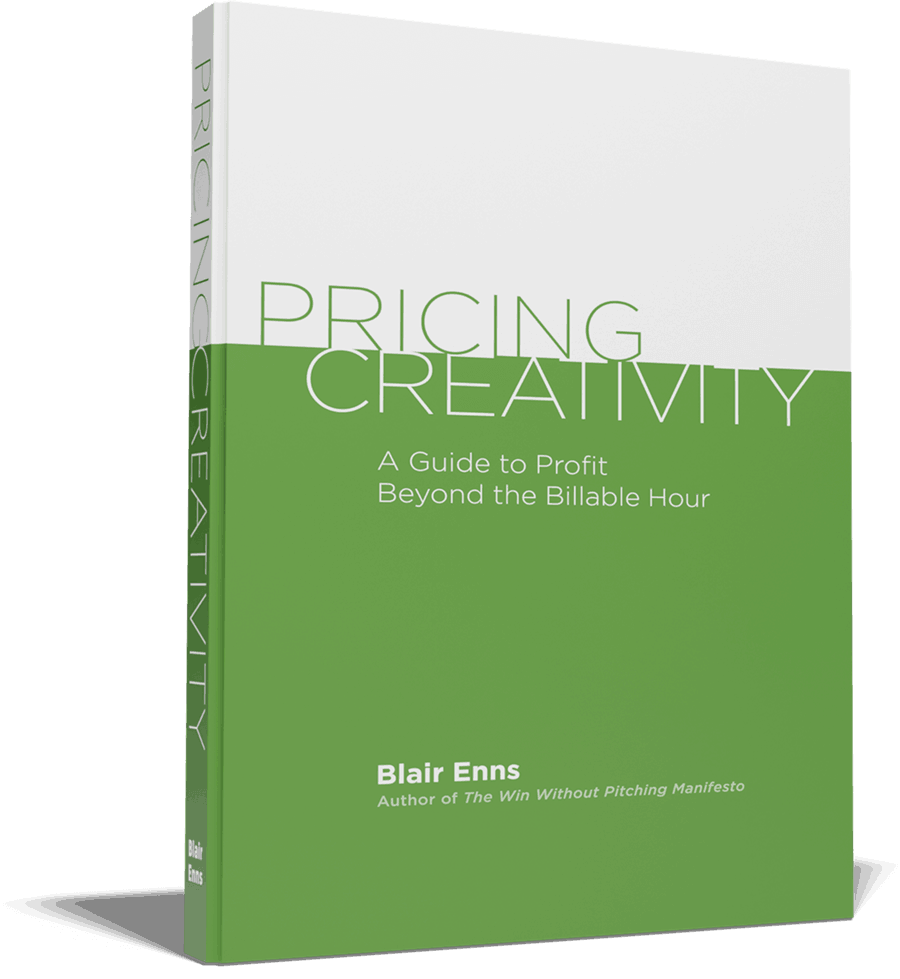I wrote the first draft of this piece in early November 2019. David C. Baker and I then used this article as an outline for a 2Bobs podcast episode that aired in December 2019. You can listen to that here.
I see many agency principals pursuing recurring revenue as though it is the answer to all of their problems. I’m not going to say that recurring revenue models are bad or wrong—they are neither—but like everything in life they come with tradeoffs, and I think most marketing firms pursuing these models are unaware of the tradeoffs until they are deep into business model changes. I further suspect that if most of these firms fully understood these tradeoffs beforehand many of them would be more discerning about pursuing recurring revenue.
In this article I will lay out the tradeoffs inherent in recurring revenue models so that if you do pursue them you will do so with your eyes wide open. Then I will explore a few types of recurring revenue models.
The Benefits of Recurring Revenue
The big appeal of recurring revenue is that, well, the revenue recurs. On its own. Every month, typically. And if you’re a business owner who’s had to fight for every client, every deal, every invoice, the idea of revenue just showing up every month is nirvana. You start to imagine that beach in Bali where you will spend the winters while your business just hums along without you.
Another benefit is that when revenue is predictable, costs can be incurred with greater confidence. The difficult decisions of when to hire or to commit to a long term lease or a building purchase become less emotional and more spreadsheet-able.
Rounding out the key benefits of recurring revenue is the issue of exit. Businesses with stable revenue are easier to sell and tend to do so at higher multiples.
It all seems pretty good, and it can be, but let’s be aware of what you’re giving up.
Recurring Revenue Usually Means Productization
I can’t explore recurring revenue tradeoffs without first revisiting the distinction between customized vs. productized services firms because most recurring revenue models require the productization of the firm’s services. There are a few exceptions that I will explore further down but let’s look at how these customized and productized services firms differ.
The Customized Services Firm
A customized services firm serves a small number of clients in bespoke engagements tailored to each client’s unique circumstances. (The ideal client roster size is typically 8-12 regardless of the size of the firm, although few firms operate at this ideal. Most have too many clients.) In such a firm each engagement is a creative act, carefully constructed to bring unique value to each individual client. As no two engagements are identical, each proposal and price is also a creative act.
A customized services firm grows in two ways: by selling deeper into existing clients and by managing a healthy churn of clients, replacing the outgoing clients with better, often bigger, new clients.
The bespoke services of a customized firm are always sold, never bought. They require a skilled salesperson whose strength is uncovering the unique forms of value most beneficial to each client. The best salespeople of customized services tend to be empathic, curious and more patient than their productized services salesperson counterparts. They are also comfortable pushing back and challenging clients’ assumptions if necessary, just as a doctor would not proceed to therapy based on a client’s self-diagnosis without first validating it for themself.
In a customized services firm there is typically one lead new business person for the firm or office, or the sale is managed by the subject matter experts themselves.
The Productized Services Firm
A productized services firm, in comparison, is built for scale. Such a firm segments the market based on buyer types, lumping together what those buyers tend to value and the prices they are willing to spend. They then tailor their services and prices to the averages of those segments, often reflected by a persona for each buyer type. Proposals, if they exist at all, are templated and standardized to the products being sold.
Customers of productized services firms give up customization, although it can sometimes be added later through third party services and integrators. (Sometimes these customized services are offered by a different division of the productized services firm.) Productized services firms grow by adding more clients. In most cases there is no theoretical maximum to the number of clients a productized services firm can serve, and the marginal costs to add more tend to be low.

Productized services are often bought, sometimes right from a website but sometimes after a conversation with a higher-drive (more competitive, less patient) inside salesperson. The sales cycle tends to be shorter in a productized firm because of the lack of customization. Productized services salespeople focus on explaining the services whereas customized services salespeople spend more time learning about the client. Productized services firms often have multiple sales people, and thus require more robust sales management.
Which Type Is Your Firm?
With these distinctions laid out, pause for a minute and ask which is your firm? Which should it be? Which type of business would you like to own and run?
While it’s true that most creative and marketing firms are, and probably should remain, customized services firms, it’s not a requirement. If you want to shift to productized, just understand the tradeoffs (below) and avoid the common mistake of being stuck in the mushy middle of a quasi-productized customized services firm.
The Tradeoffs of Productized Recurring Revenue
As soon as you start to productize your services you feel the forces of commodification closing in. Where each engagement, proposal and price were once creative acts, you begin to standardize all three. At first this is exciting because all the customization you do for your clients both in the sale and the engagement is time-consuming and difficult. You imagine that once and for all you are going to define, package and price the perfect set of solutions and you imagine that at each sale you will simply reach onto your shelf and assemble the solution from your packages that best match the client’s challenges. You’ll treat your proposals the same way, you imagine. Everything will become modular.
In your mind, all the previous messiness of the customized services model starts to get Marie-Kondo’ed. “This business of mine is going to be neat and tidy,” you think.

Then you quickly learn that while you built products for the average buyer in a segment, nobody is exactly average. This has been proven repeatedly across numerous studies. Averages are simplified composites of many individuals, and when you examine the individuals that make up the average, you learn that no one individual looks like the average of many. I mean, none. Zero.
Inherent in every sale of a productized service therefore is some compromise of fit. Your productized service is good for the average in a segment but perfect for nobody. That doesn’t have to be a deal killer for recurring revenue models, just recognize that when you productize, your client trades a customized fit for an approximated fit. They give up customization.
So, what does the client get in return for giving up a perfect fit?
They get a lower price.
And how do you, the business owner, make the lower price (and margin) work for you?
You add volume.
Scale Is a Requirement When Productizing
So the tradeoff is the client gives up customization (perfect fit) but gets a lower price. You give up margin in exchange for volume. Therefore if you standardize your products and prices you must pursue scale. The entire culture of your firm must shift to the pursuit of scale at the cost of customization.
This requirement for scale is the most fundamental tradeoff of productization in pursuit of recurring revenue and most creative or marketing firm owners don’t see it. As they dabble with productization they find that each client wants a few things tweaked to their unique circumstances. As the firm obliges, they move unwittingly to the mushy middle of a quasi-productized business model without the requisite scale. The inevitable outcome is a decrease in pricing power and profit.
Is this where you are now? Have you traded one set of problems (the complexity and cost of customizing the sale and the engagement to each client) for a less profitable business? Have you Marie Kondo’ed your services, proposals and prices only to find you’re encountering maddening new price pressures?
In my experience, digital firms tend to be most prone to falling into this trap of the mushy middle, particularly those reselling or adding services onto SaaS products. They envy the recurring revenue their clients are paying to their marketing automation or CRM partner and so they try to replicate the model, standardizing offerings and prices, without appreciating how commodifying the forces are and how much scale is required to compensate.
Scale Requires a Different Culture

As a customized firm, you have ~12 clients but if you’re going to productize you need more like 120, or even 1200. You’re likely going to need a salesforce. Which means sales management. And because of your lower margins, your culture needs to move from one of innovation seeking to efficiencies seeking. You need to become a systems maven. You no longer hire high-priced freaky creative people because the magic is no longer in the people, it’s in the product and systems. You move to hiring lower priced, more interchangeable people who will follow the prescribed process. You no longer need the expensive cool office space to lure those coddled geniuses. Cubicles and fluorescent lighting will do. Okay, I’m exaggerating a little for effect but the point is productized services firms that trade margin for scale are different in every way from customized services firms. The trade-offs are far reaching. This is not a decision to be made lightly.
Productizing Properly
Is it possible to realize the benefits of productizing without giving up margin and a significant culture change?
It’s possible. Let’s explore how to have your cake and eat it, too.
Spin Off the Products
The most common example of revenue that recurs from a productized service is a digital firm that also does hosting or that has developed an app or other piece of technology. Understand that these are effectively two different businesses in one. Both are viable but they should be separated from each other before too long because the cultures are different.
The digital marketing firm has a roster of ~12 clients that turns over at a rate of 3-4 clients per year. The hosting and maintenance subsidiary has a larger and growing client base that turns over more slowly. The latter business arises out of the former. In the beginning all hosting clients come through the marketing firm. At some point the obvious questions arise: Should the hosting firm pursue its own clients? Should it hire salespeople or strike strategic partnerships with the marketing firm’s competitors?
In the parlance of the unbundled corporation model, the marketing firm is an innovation business and the hosting company is an infrastructure business. When an innovation business spawns an infrastructure business, as sometimes happens, the first realization is that the infrastructure services can be sold to the innovation business’s competitors. These are now two different businesses that should be unbundled.
FunctionFox is the company that owns TimeFox, a hosted time-tracking and project management app for small agencies. It’s a piece of infrastructure that ad agency Suburbia Studios built for itself and then realized it could spin off and sell to its competitors. It did so quite successfully.
Traction On Demand (Traction) is a Salesforce.com (Salesforce) consulting company. (I paid Traction $4k to customize our Salesforce instance more than a decade ago back when founder Greg Malpss was the sole employee. Today they have a team of almost 1,000 and growing rapidly. They are one of the world’s largest and most successful independent cloud computing consultancies.) In their customized consulting work, Traction has occasionally found themselves developing products for clients that they realized they could sell to other companies at scale. In these examples Traction retains the IP for the new product and, instead of quasi-productizing the customized services business (or quasi-infrastructure-izing the innovation business), they eventually spin the product off into its own company, with its own dedicated staff and venture backers. They have now done this multiple times. (See their impressive product portfolio here.)
Monetize the Low End of Your Market
There are examples of customized services firms spinning up products and keeping them in house without negatively affecting the success of the firm. It’s almost always an attempt to monetize the low end of a large market. A few variables have to be in place for this to work, and the big concern is ensuring the product serving the low end does not cannibalize the customized services serving the high end.
Here I will use my own business as an example. Since 2013 Win Without Pitching has been a training company—productized and pursuing scale. In its first decade, from 2002 to 2013, however, it was a solo consulting practice. As a small customized services firm, I worked with 1 to 4 clients at a time.* Back then I wrote and published frequently and managed to build an opt-in list of thousands of independent agency professionals. I realized though that many on my list would never hire me (they couldn’t afford my fees, were not in ownership positions or were too removed geographically) so I decided to launch a productized service (a paid webcast subscription) for a low price ($49-$99/mo).
For ten years until I shut it down a few years ago, that low-price, high-volume product generated net new revenue without much extra effort.
Beware Cannibalizing Your Lucrative Customized Services
My own example might be closest to what many firm owners are thinking about when they consider recurring revenue, but too often that cheaper product cannibalizes the more lucrative customized service.
In my case it’s possible there was some cannibalization of higher priced consulting services but that was more than offset by the recurring revenue and the consulting engagements that first came to me through the productized offering. In the end it not only drove more revenue on the product side, it drove more revenue on the customized side.
Sounds like easy money, doesn’t it? Hold on because there are clear reasons why it worked for me. If these factors are in place, you might consider doing something similar. If you’re missing any of them then you’re likely to run into trouble. In my case:
- The market was large. There are millions of independent creative and marketing firms or professionals out there.
- I had already built a sizeable list of people I could sell to in that market
- I had earned some trust/credibility with this market through years of content creation
- The product was sufficiently different from the customized service. A webcast, like a blogpost, delivers fairly universally-applicable information but it does not customize that information to any one individual. It’s the custom application of that guidance for which the consultant earns the big bucks.
- The content was a la carte and random, and not ordered into a DIY course. The price was cheap but any potential consulting client who attempted to get similar value out of the product would have had to invest in time what they hoped to save in money, and most successful people will pay money to save time. This limited cannibalization.
Here’s another way to look at it: Can you easily monetize your marketing?
I first considered doing a regular webcast for free as a marketing channel but I already had a sizeable audience through my writing. I needed to monetize it better. It was clear to me that because I had all the above factors in place I could do webcasts as marketing and charge for them. They would drive leads and revenue.
Are you already marketing to a large audience who finds value in your marketing but many of whom will never hire you? Have you already built trust with this audience? Can you offer a productized service to this audience that does not allow customized services clients to drop down and buy your cheaper product instead? If you answered yes to all those questions then I would say consider trying to monetize the low end of your market through a productized service, but I suspect most reading this cannot meet this criteria and would be better off focusing on the messier but more lucrative bespoke services for fewer clients.
There Are Some Recurring Revenue Models for Customized Services
While most recurring revenue models require productization and scale, there are a few that do not. One is a specific type of subscription model—a big topic with lots of nuance that I will explore in depth in a future post—and another is retainers, to which I devoted a whole chapter in Pricing Creativity: A Guide to Profit Beyond the Billable Hour so I will address only briefly here.
Retainers
Retainer relationships are a form of recurring revenue for non-productized but usually narrowly-specified ongoing services. Retainers provide smoothed out cashflow and are a valid pricing model that should be considered part of your pricing mix. But any business built entirely on retainers for inputs and outputs solves one problem (cashflow variability) while giving up the ability to earn the extraordinary income that can only be obtained by pricing on value in a fully customized engagement.
A customized firm using retainers can plan expenses with a high degree of certainty, allowing the principal to sleep better, but that’s about the only benefit. For many, however, that’s enough. While a retainer-only firm is trapped in the mushy middle, it’s perhaps at the safer end. Retainers don’t scale and they don’t allow for the extraordinary compensation that a more bespoke engagement might. They also don’t remove the uncertainty discount built into the sale price of a customized services firm as clients can still walk at any time and might be inclined to at a change in ownership.
Avoid the Mushy Middle
The lesson again is that every decision involves tradeoffs—giving something up to get something else—and the pattern I see is agency principals being drawn to recurring revenue models for the reasons I cited at the top of this article, but without fully considering those tradeoffs.
Further, the most common pattern I see is a pull towards productization but not a full commitment to it. So we have many firms with a foot in each camp, making their business a little less messy by standardizing services into packages with set prices, but not adding the scale required to offset the commodifying forces that such standardization invites.
I laid out a few ways to productize properly, and they are worth exploring, but to the majority I would encourage you to stay customized. In those bespoke engagements look for opportunities for extraordinary value creation, and, where possible, price some of those engagements based on the value created rather than inputs, outputs or the “market value” of packaged services. It’s a messier business but there is money in the mess.
*In truth, at that time Win Without Pitching was a great example of a quasi-productized customized services firm, caught in the mushy middle, selling pre-packaged consulting services at set prices but without the scale. When I realized this mistake I knew I had to fully productize and pursue scale, or fully customize—become truly bespoke—and price based on the value I proposed to create. Either choice would have been fine. I choose the former. Let’s leave that aside for now. For the purposes of this discussion I was running a consulting firm with a small number of clients, I was just doing it a bit wrong.

